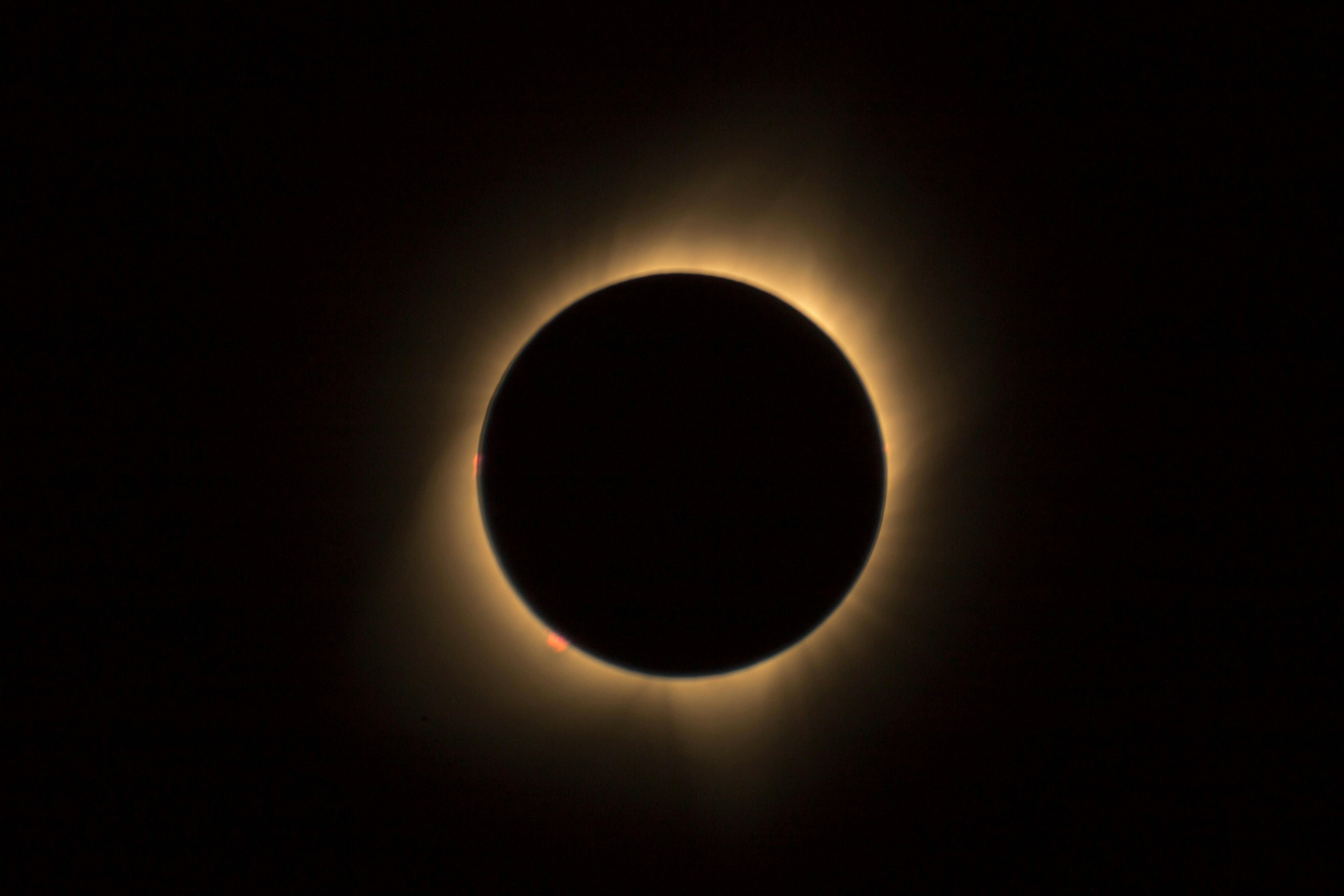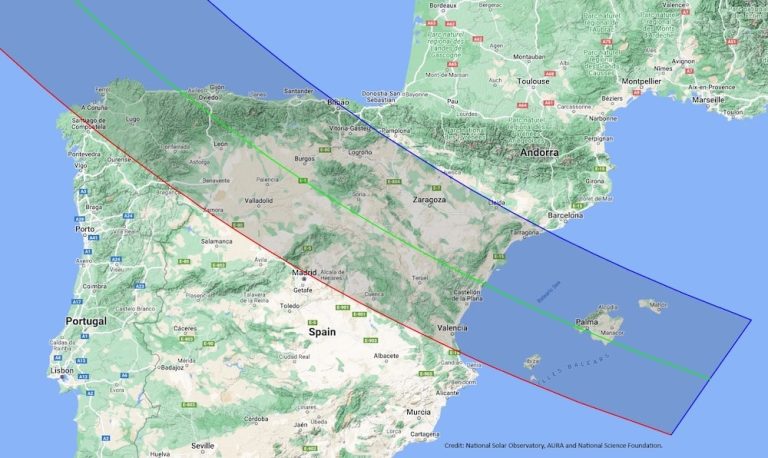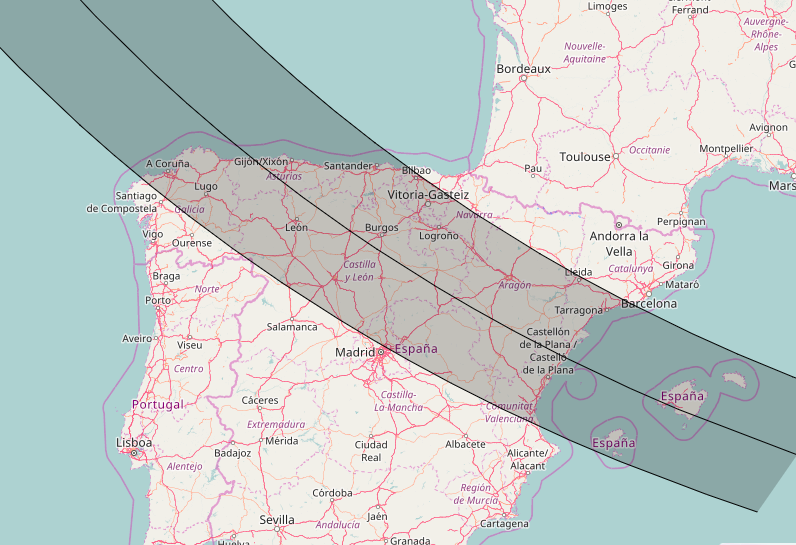Gallery
Eclipse Images & Visuals
August 12, 2026
Eclipse Path Visualization
Explore the path of totality across Spain and see where the eclipse will be visible from different locations.



Eclipse Phases
Learn about the different phases of a total solar eclipse and what to expect during each stage.
Partial Eclipse Begins
The Moon starts to cover the Sun, creating a crescent shape. This phase lasts about an hour and requires eye protection at all times.
Total Eclipse Begins
The Moon completely covers the Sun, creating total darkness. This is the most spectacular phase and the only time it's safe to look without protection.
Maximum Eclipse
The peak of totality, when the eclipse is at its maximum. The Sun's corona becomes visible, creating a breathtaking sight.
Total Eclipse Ends
The Moon begins to move away from the Sun, ending the total phase. Eye protection must be used again immediately.
Viewing Locations
Discover the best locations across Spain to witness this rare celestial event.
Madrid
Retiro Park and Casa de Campo offer excellent viewing opportunities with good accessibility and facilities.
Barcelona
Montjuïc and Parc de la Ciutadella provide spectacular views with the Mediterranean Sea as a backdrop.
Valencia
City of Arts and Sciences and Turia Gardens offer modern viewing locations with cultural significance.
Seville
Maria Luisa Park provides a beautiful historic setting for eclipse viewing.
Safety Equipment
Essential safety equipment for viewing the eclipse safely and comfortably.
Eclipse Glasses
ISO 12312-2 certified eclipse glasses are essential for safe viewing during partial phases.
Solar Filters
Professional solar filters for telescopes and cameras to capture the eclipse safely.
Pinhole Projectors
Simple and safe method to view the eclipse indirectly using cardboard and a pinhole.
Solar Telescopes
Specialized telescopes designed specifically for solar observation with built-in safety features.
Photography Tips
Capture the eclipse safely with these photography techniques and equipment recommendations.
Camera Equipment
Use a DSLR or mirrorless camera with a telephoto lens. A tripod is essential for stability.
Solar Filters
Always use proper solar filters on your camera and lens. Remove filters only during totality.
Settings
Use manual focus, low ISO, and fast shutter speeds. Practice before the eclipse day.
Safety First
Never look through the viewfinder without proper protection. Use live view or remote shooting.
Historical Eclipses
Learn about previous total solar eclipses and their significance in history and science.
Ancient Observations
Historical records of eclipses from ancient civilizations and their interpretations of these events.
Scientific Discoveries
Important scientific discoveries made during total solar eclipses, including Einstein's theory of relativity.
Cultural Impact
How eclipses have influenced art, literature, and culture throughout history.
Modern Observations
Recent total solar eclipses and the scientific research conducted during these events.
Interactive Elements
Engage with interactive content to learn more about the eclipse and prepare for the event.
Eclipse Simulator
Interactive tool to see how the eclipse will look from different locations in Spain.
Timeline Tracker
Real-time countdown to the eclipse with detailed timing information for your location.
Weather Forecast
Live weather updates and cloud cover predictions for optimal viewing conditions.
Community Photos
Share your eclipse photos and see images from other observers around Spain.
Educational Resources
Educational materials and resources to help you understand and prepare for the eclipse.
Eclipse Guide
Comprehensive guide covering all aspects of the eclipse, from science to safety.
Activity Sheets
Printable activity sheets for children and families to learn about eclipses.
Video Tutorials
Step-by-step video tutorials for safe viewing and photography techniques.
Expert Interviews
Interviews with astronomers and eclipse experts sharing their knowledge and experiences.
Share Your Experience
After the eclipse, share your photos and experiences with the community.
Photo Contest
Submit your best eclipse photos for a chance to win prizes and recognition.
Story Sharing
Share your eclipse experience and read stories from other observers.
Community Gallery
View photos and videos from the eclipse community across Spain.
Social Media
Connect with other eclipse enthusiasts on social media platforms.
Coming Soon
We're working on adding more interactive content and features to enhance your eclipse experience.
Interactive Features Coming Soon
- 360° virtual reality eclipse experience
- Interactive eclipse path map
- Real-time weather monitoring
- Live streaming from multiple locations
- Augmented reality eclipse viewer
Stay tuned for updates and new features!
Get Notified